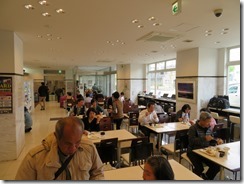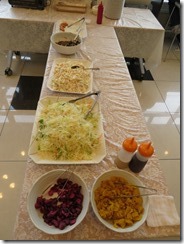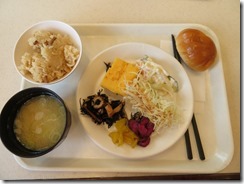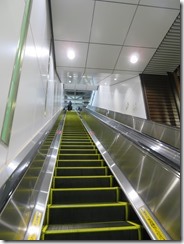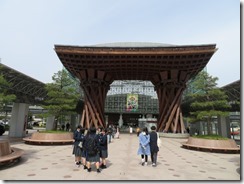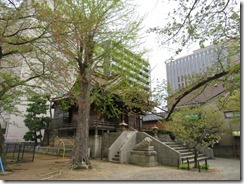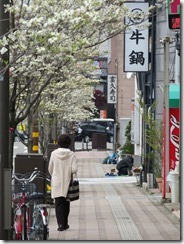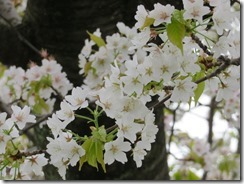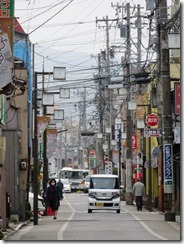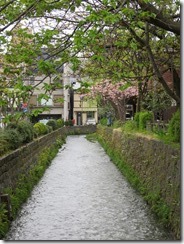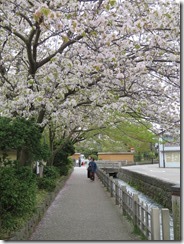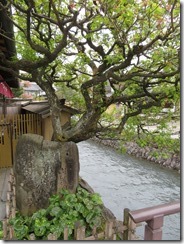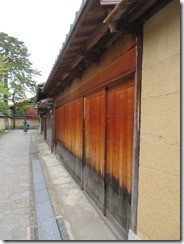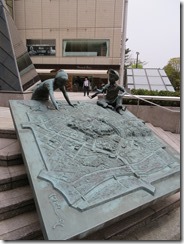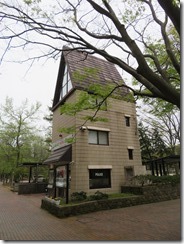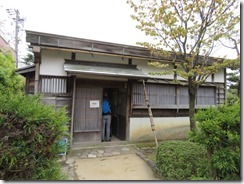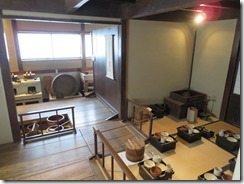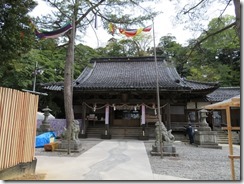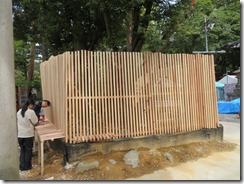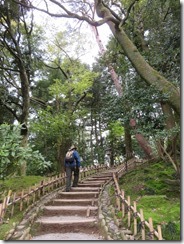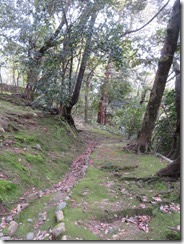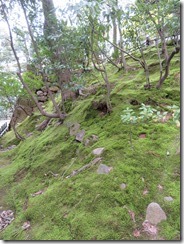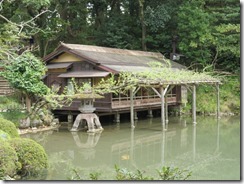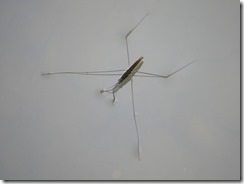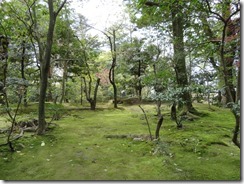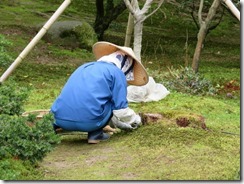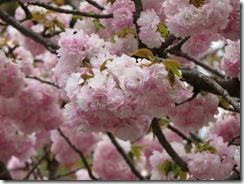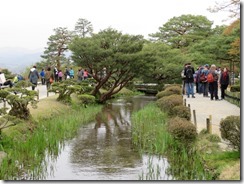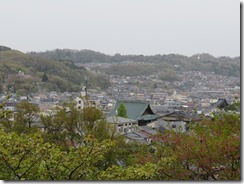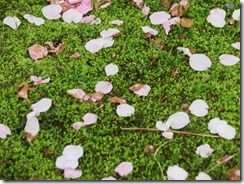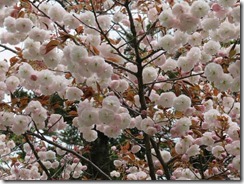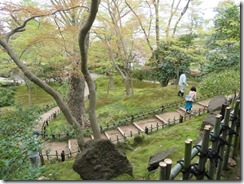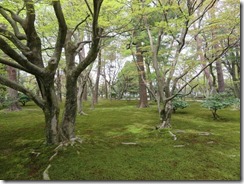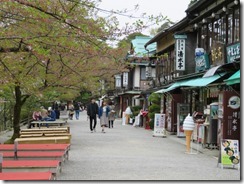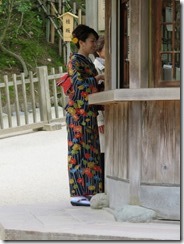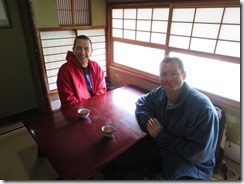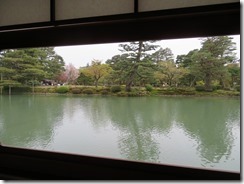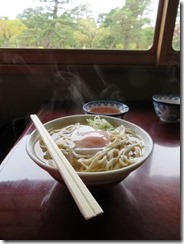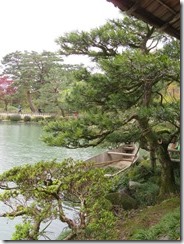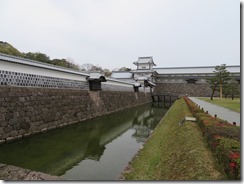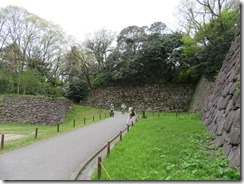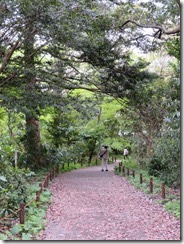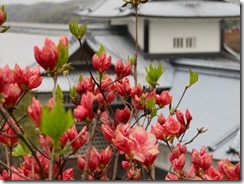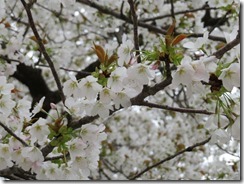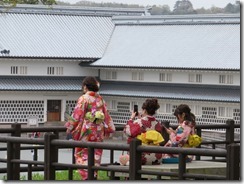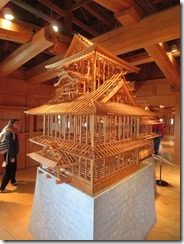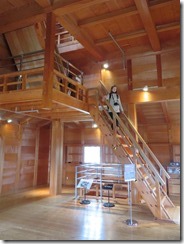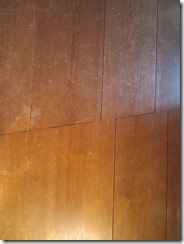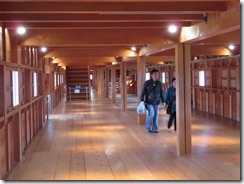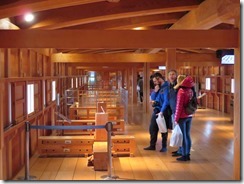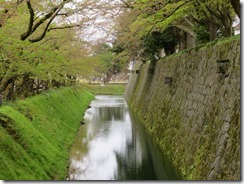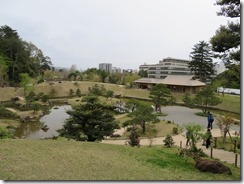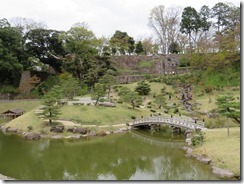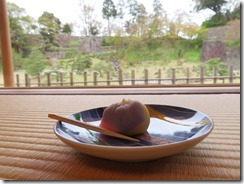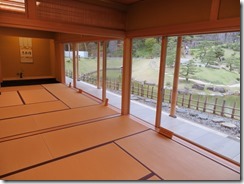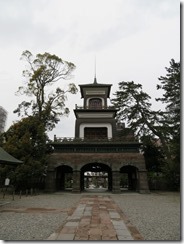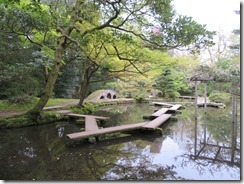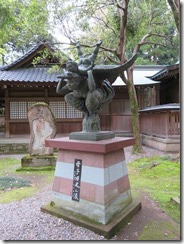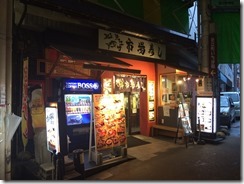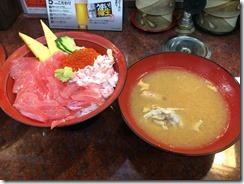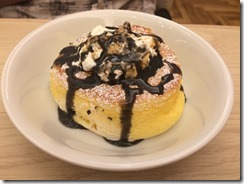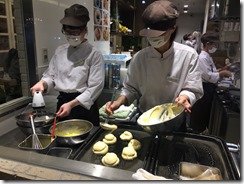One trouble with coming in mid-spring is how middling the temperature is. That may be a bit confusing, so let me explain: in the summer, it’s hot, so we can go around in short sleeves all the time. In winter, it’s cold, so we can go around in jumpers all the time – maybe even thermals. Here in April, though, it’s middling. Warm in the sun, cold after sunset, so if it’s warm enough to not need our jumpers, we still need to carry them around in case the weather changes. And with all our camera straps and bags and whatnot, putting on or taking off a jumper can be an ordeal. Fortunately, it’s cool enough here in Hokuriku for full-time jumper-wearing. Maybe even thermals.
Started with breakfast in our new hotel’s lobby. This hotel is a bit larger than our last, and the breakfast room is correspondingly larger. And quite crowded.
After breakfast, we headed out for our planned activity: spending the day in Kanazawa, in nearby Ishikawa Prefecture, which we reached by hopping back onto the Hakutaka train. Tragically, I realised seconds after settling into my seat on the train that I’d left my umbrella hooked on the edge of the counter in the ticket office.
Kanazawa is the capital and largest city in Ishikawa Prefecture, with a population of 466,029 – in fact, it’s the nearest major city to Toyama. During the Tokugawa Shogunate it was ruled by the Maeda clan, who through shrewd dealings were able to increase their holdings into the largest feudal domain within the shogunate, and in the 1700s, the population of the city already rivalled that of other major word cities of the time like Rome and Amsterdam. The city’s name means “gold marsh”, springing from a legend that a peasant digging for potatoes found gold flakes instead – today, Kanazawa produces about 99% of Japan’s gold leaf, including all the gold leaf that covers Kinkaku-ji in Kyoto.
Our trip was brief but uneventful, and soon we were heading through the streets of Kanazawa. First, we decided to head for the Nagamachi District, a part of town which still retains its streets and buildings from when the samurai used to live there. It was quite a nice little district, with lots of old buildings. Even a few canals, flowing quite strongly – James thought they might be snowmelt, but neither of us cared to test the water temperature in order to find out, even if we could reach the water.
One building – formerly a home for a low-ranking samurai foot soldier – was open to enter and wander around for free, so we did. We had to take our shoes off to enter, but James had decided today of all days to wear his lace-up walking shoes today instead of his slip-on shoes. It was quite a nice little place, all the same.
Roughly at this point, my camera battery ran flat (about the same time as it would any other day), but when I went to change to my first spare, I discovered to my horror that I’d left it sitting in the charter in the hotel. I’m having a great day so far, aren’t I? I switched to the second spare, a little bit worried, but not too concerned, since so far this trip, I’ve only needed one spare each day.
After that, we curved to the left to head for our next destination. Before we reached it, we decided to pop into a shrine by the name of Ishiura Shrine (the name comes from an old name for the area – means “stone bay”). Mostly it caught our eye because they seemed to be setting up for some kind of event, probably on tonight. Still no particular idea exactly what festival, but I decided to get a goshiun all the same. As I waited at the window, a few ladies who had already handed over their books caught sight of my own book, and were extremely impressed by how many I had collected. They were so impressed that I briefly forgot that when you’re complimented in Japanese, the appropriate response is not to thank them, but to downplay your accomplishment. “No, it’s not that impressive” kind of thing. James even managed to earn some kudos just by association. I compared notes with one of the women – we both had Matsunoo Taisha in Kyoto, for example, but she was quite amazed that I also had nearby Koke-dera as well.
But anyway, our main reason for heading in that particular direction was to visit Kenroku-en. Meaning “Six Attributes Garden” (with the attributes in question being spaciousness, serenity, venerability, scenic views, subtle design, and coolness), Kenroku-en is regarded as one of the Three Great Gardens in Japan, along with Koraku-en in Okayama, Okayama Prefecture, and Kairaku-en in Mito, Ibaraki Prefecture. Originally part of the gardens of the adjacent Kanazawa Castle, it was first opened to the public in 1874.
It certainly was quite an impressive park. We wandered all around looking at things – moss-covered beds, towering trees, more than a few flowers, two large ponds, and even Japan’s oldest fountain – still operating, gravity-fed from the upper pond. For an added bonus, we were actually able to see a cherry blossom tree still in bloom – one of a species that blooms later than others. Just the one, though, so we didn’t really get the full cherry blossom blizzard effect.
After a bit of a wander, we stopped for lunch at a building built almost over the water. We sat in tatami-mat room at a low Japanese style table at ate tsukimi soba – soba noodle soup with a raw egg broken into the middle – and gazed out over the pond. Quite relaxing. Quite tasty. Also, marked the second time we had to take our shoes off today.
After lunch, we looked around the park a bit more, then crossed a bridge and entered the Kanazawa Castle gardens. The castle buildings used to occupy almost the entire area of the gardens – sadly today, only a handful remain, with the rest having burnt down in a fire in 1759. Part of the castle – comprising a gate at one end, an arrow turret at the other, and a hundred-meter-long warehouse in between – was restored in 2001 using traditional construction methods – all interlocking tennons and dovetails and keys in notches, all held together with wedges, no glue.
We looked around the outer gardens for a while, and they were also quite nice. Some parts were heavily forested, but the remaining foundations of arrow turrets offered some quite spectacular lookouts.
Then we headed in to see the reconstructed castle buildings. It wasn’t all agéd like Matsumoto Castle, but in form it still looked like a proper old castle, just done in new wood and varnish. Not, you know, marble and air conditioning like the Osaka Castle restoration. The weirdest thing is that the everything in the building’s floor plan – outer wall shape, floor board and ceiling joust angles, even the supporting columns – is a diamond shape, not quite square, with angles of 80° and 100°, just the same way as how the original castle was constructed. It was… quite weird. I’m just relieved the walls were vertical and the floors were horizontal. We once again entered with no shoes – de-shoering number three.
After we’d seen the castle building, we headed down to Gyokusen’in, a small garden built for the wife of the second lord of the domain, below the walls at the back of the castle. It was quite a nice little garden, with a pond and a waterfall, and little bridges. I quite liked the way the castle walls towered over the garden (and, indeed, that’s described as one of the highlights).
It also contained a tea house, where we decided to order the matcha tea and traditional sweet set. We juuust managed to get there in time, entering right at 4pm, the time for last orders of the day. One other couple was already there. It was incredibly serene, with a panoramic view of the gardens through the windows. Matcha is often served with traditional sweets – the sweetness of the sweet is intended to directly contrast the bitterness of the tea. And, for the fourth time, we needed to remove our shoes.
I’d hoped to visit one more district in town – Higashi Chaya, the old geisha district, but it was starting to get on, so I decided we should skip that and head to the next attraction instead. But on the way, we got distracted by another shrine, this one named Oyama Jinja. It too had quite a lovely garden, with a nice pond, with bridges and boardwalks running all over it. One of the shrine’s most distinctive features is its entrance gate – instead of the usual torii gate typical for shrines (though there was a separate torii outside the main gate), or even the Chinese-style gate used for temples, Oyama’s main gate is instead a three-storey tower, combining elements of Japanese, Chinese and European religious architectural elements, including Dutch stained-glass windows on the third floor. I still don’t know the story behind that, and my quick Google hasn’t turned up much (though the reasoning for Dutch influences at least is clear, since the Dutch have been trading with Japan for quite a while).
At this point, my greatest fears came to pass: my first backup camera battery went flat. I managed to squeeze out a few more photos by draining both batteries completely dry, but my photo-taking basically stopped at this point, though I did take a few on my phone. James took more photos, so I’ll need to get them from him later.
Shortly after leaving there, it sadly started to rain – as the weather forecast predicted, actually – but fortunately we were able to reach our next destination before it got too hard. The destination in question being Omicho Market, a huge covered market comprising 170 stores in a small network of streets. Sadly, many of the shops were already closing or closed – it was after five, though I confess I had been expecting they’d stay open longer.
We stopped for dinner in one place that was still open – sushi. James had a “chef’s recommendation” nigiri plate, while I had a tuna belly meat rice bowl with shredded crab and salmon roe. Both came with a type of miso soup made by boiling fish scraps together. A little bit… weird.
After dinner, we headed back to the station to try out some Japanese-style pancakes on the recommendation of a mutual friend. The shop was named “Happy Pancakes”, and for most of our visit, we were the only males in the store – it was almost filled with school girls. We decided to have roasted soybean flour almonds with black sesame sauce, to try something more exotic. Quite tasty.
Pancakes done, we booked shinkansen tickets for our trip back to Toyama, boarded the train when it came, and headed back to our hotel. On the way, we dropped by the ticket office to see if they had a lost property. For those who have been sitting on the edge of their seat since the third paragraph screaming “but what about the umbrella!?” you can now rest assured – my umbrella and I have been reunited. I even used it on the walk back to the hotel.
Tragically, tomorrow’s forecast is rain. Rain, rain, rain. Which is seriously unfortunate, because tomorrow is one of the most major outdoor activities planned for this trip. We’re going to press on with it and hope, because we haven’t got much alternative (it’s how we’re getting to our next hotel). Fortunately, Thursday’s weather is forecast to be sunny.
Today’s photo count: six hundred and forty-seven, including the ones I took on the phone.
Today’s pedometer count: 20,236 steps, for 15km
Today’s goshuin count: Two – Ishiura Shrine and Oyama Shrine
Today’s stamp count: One – Kanazawa Station

